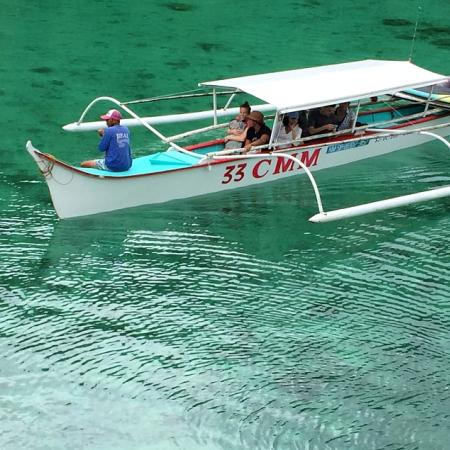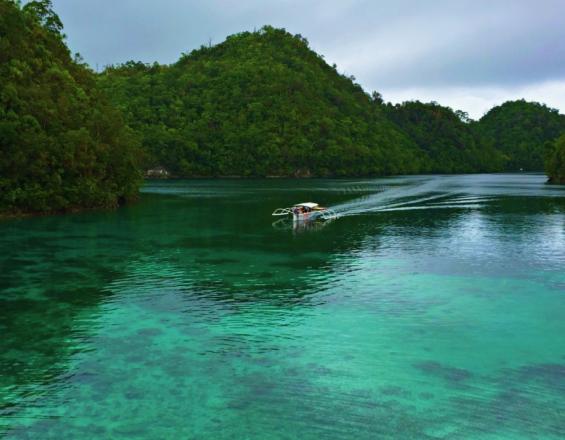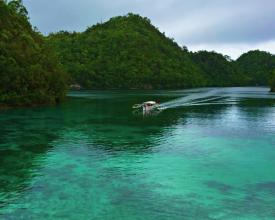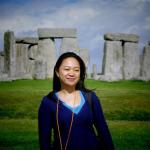
Balancing Environment Conservation and Economic Gain Through Community-based Tourism

Sugba Lagoon demonstrates that tourism need not be a choice between conserving the environment and earning a living:
1. 2 peoples organizations from Caub, where the lagoon is, and from nearby areas were tapped to provide transportation and guest relation services. They were trained on tourism management by the LGU and other government agencies, and SIKAT, a 28-year old NGO with significant experience in community-based coastal resource management trained them on basic ecology and Marine Protected Area Management. The POs were registered as organization and environment management is part of their mandate.
2. The LGU declared the lagoon as no-fishing zone and intensified its enforcement of fisheries laws with help from POs and NGOs.
3. The LGU developed infrastructure and procedures, providing support and guidance.
4. The communities are kept informed of policies and importance of environment conservation through regular community consultations.
Contexto
Défis à relever
The Sugba lagoon tourism project helped the commuties realize that environment conservation and income generation is not a zero-sum game, rather, they go hand in hand. This realization helped the local government and NGOs get the buy-in that they need from the communities for their intensive campaign against illegal fishing and illegal mangrove cutting. As the income earned from tourism is helping to augment the income of the families in the communities, this project also helped address the issue of declining fish stock which was a serious threat to the municipality’s food security and livelihood.
However, the unexpected surge in the number of visitors caused concerns with regards waste generation which prompted the LGU's monitoring team to recommend the lagoon's temporary closure for rehabilitation. Since its re-opening, the LGU has put a limit to the number of visitors, implemented "no plastic" and "no garbage" policy and prohibited the bringing of food.
Ubicación
Procesar
Summary of the process
The good relationship between the various stakeholders is the locus which holds the Sugba eco tourism project together. The leadership provided by the Del Carmen local government enabled the participation of the communities, as well as the non government organizations and the establishment of the people’s organizations. The local government unit provided the infrastructure, and through the tourism office, guidance and support were provided to the people’s organization which is very crucial in making the project organized. The participation of the community members through the POs enabled the smooth operation of the eco-tourism project, and also ensured the success of the local government’s environment protection and restoration campaign. The contributions from government agencies and non-government organizations were as important, as they worked together to build the capacities of the POs and empowered them to carry out their environment protection mandate and to manage the eco tourism program.
Building Blocks
Organized community groups and participatory approaches
The active participation of organized community groups like DECATPOA , a People's Organization (PO) from Caub village where the lagoon is, and BACAMA, a PO composed of fisherfolk is crucial in this community-based venture. Both POs were registered with the Security and Exchange Commission, were trained and deputized by the LGU to do environmental management, particularly management of marine protected areas. SIKAT, a non-government organization with significant years of experience in community-based coastal resource management trained them on basic ecology and provided them training and support on Marine Protected Area Management. Both POs have clearly defined organizational set-up, system of rules, defined roles and clear objective on sustaining resource management.
Enabling factors
- That the mayor of Del Carmen is a firm believer of capacitating the communities, has enabled the success of this building block. He encouraged the creation of and strengthening of people’s organizations in every village.
- The members of the POs were willing to be volunteers. Their commitment is invaluable as they invested time and effort even if they were not sure they will earn from the venture. They believed not only in the economic benefits of tourism, but also in the importance of conserving and protecting their environment.
Lesson learned
Having a leader who believes in empowering communities makes it easier for the community members to participate in and commit to community-based ventures. The spirit of volunteerism should be alive in the community for them to participate even if the economic benefits are not yet realized.
Undergoing training on basic ecology and marine protected area management, and being provided wth technical support by SIKAT, helped them gain better appreciation of the different strategies, as well as issues on marine protected area management.
Technical support from different sectors and infrastructure support from LGU
To empower the people's organisations, government, NGOs and private entities shard their expertise and provided them technical support. The LGU, government agencies and NGOs trained them to be able to manage their own organisations, practice community based management, and the technical skills on how to manage tourism activities. SIKAT, an NGO with significant years of experience in community-based coastal resource management program implementation also provided them with training on basic ecology and training and technical support in Marine Protected Area Management.
Enabling factors
- Partnership and good working relationship of LGU with other government agencies, non-government organizations and private entities
- The ability of the LGU to network also helped them gain support from other government agencies, who provided them with trainings on the different aspects of tourism, and helped build their capacities to manage their organizations.
- An NGO provided them training on ecology and Marine Protected Area Management to capacitate them in their environment management role
- Participatory process in the identification of trainings.
Lesson learned
- Capacity building on organizational skills and on environment conservation is as important as the technical trainings on tourism management.
Continuous communication and education
Through community consultations, the LGU and non-government organizations regularly update the communities on policies and reminds them of the possible impact if the lagoon is degraded. Dialogue on issues and discussions on solutions happen during these community consultations. Information, Education and Communication materials in brochure form are handed out and posters are placed in strategic locations.
Enabling factors
- Participatory approach through community consultation facilitates the participation of the communities
- The PO members have been empowered to do consultations with the other community members.
Lesson learned
- Community commitment on resource management and conservation depends on their level of understanding of the actual situation of their environment, ability to recognize the social and economic impacts of degraded resources, and acknowledging that they have the capacity to make their environment better.
Strict implementation of fisheries law and ordinances
The municipality of Del Carmen showed that it is serious in the implementation of fisheries law and ordinances when it organized the fish wardens and the People's Organizations (POs) in all its villages. The local government and the Center for the Development of Indigenous Science and Technology or locally known as SIKAT, a non-government organization and a member of the Locally Managed Marine Area (LMMA) Network, provide the fish wardens support in form of training, honorarium and provision of supplies. The fish wardens , in partnership with law enforcers, are instrumental in the apprehension of illegal fishers and illegal mangrove cutters and in significantly lowering down the number fishermen practicing said illegal activities. The people’s organizations were also trained and deputized by the LGU and were instrumental in the protection of designated protected areas. Sugba Lagoon likewise became a “no-fishing” zone. These efforts helped in slowly restoring the marine resources of Sugba Lagoon, and of Del Carmen.
Enabling factors
- The political will of the local government unit.
- The campaigns done by both the local government and SIKAT against illegal fishing and illegal mangrove cutting which has been underway for years helped the communities correlate environment conservation and food security. This knowledge motivated them to cooperate and participate in the people’s organizations for the establishment of the lagoon eco tourism project.
- Support in the campaign against illegal fishers and illegal mangrove cutter from the NGOs and people’s organizations.
Lesson learned
- Community members should be consulted and highly involved in the drafting of fishery policies
- Approved municipal ordinance should be clearly communicated to stakeholders using different communication mediums.
Impacts
Making Sugba Lagoon tourism a community-based social enterprise provided the communities with the opportunity to partake in the socio-economic benefits of tourism and to take ownership of their responsibility to conserve their environment. The income provided by the lagoon motivated them to strictly implement the “no fishing policy” in the lagoon. Through community based eco-tourism, the members of the communities realized that it is possible for them to earn without destroying the environment.
Through capacity building activities organized by government agencies and NGOs, the people's organizations (PO) acquired skills in tourism management such as customer service and souvenir packaging, and organizational management skills such as financial management, team management and project management.
The knowledge and appreciation of the communities on the importance of environmental protection and conservation increased because of their training on basic ecology and protected area management, community consultations and information campaigns conducted by the POs, the LGUs, SIKAT and other non government organizations.
As a result of their involvement, their training and their mandate to manage their envonment, the PO members have become empowered members of their communities as well as protectors of environment.
Beneficiaries
- The community where the lagoon is located, and neighboring communities
- Members of the 2 people's organizations
- Small scale fishermen in Del Carmen who experienced increase in catch as a result of protected coastal habitat and well managed fishing grou
Story

Sugba Lagoon: A Story of Collaboration for Community-Based EcoTourism
Sugba Lagoon is a story of how a local government unit (LGU), communities and NGOs work as one to create the balance between economic gain through tourism, and environmental conservation.
When Sugba Lagoon opened to tourists in 2015, The mayor of Del Carmen, tapped 1 People's Organizations (PO) from Caub village where the lagoon is, to manage guests and a PO composed of fisherfolk to provide transportation services.The POs were trained on tourism management, and organizational development. SIKAT, a non-government organization with significant experience in implementing community-based coastal resource management and a member of the Locally-Managed Marine Area Network provided them with technical support and trainings on basic ecology, and protected area management, among others.
The LGU developed infrastructure and procedures. The tourism office, manage the dispatch of boats, collection of fees and distribution of revenue to stakeholders. Jems , president of the PO for transportation and a former illegal fisher, describes their working relationship with the LGU’s tourism office as "We're like one body." This kind of team work enabled them to weather the first months when they were averaging only 5 trips per month. Sonny, president of the PO managing the guests, shared that they have always believed that tourism will pick-up. For Jems, it was their trust in Mayor Coro’s word that kept them going. Their trust was well placed, as tourism indeed picked up soon.
After the lagoon was featured in a national news magazine program and posted in instagram by a Philippine actress/TV host, the tourism office saw a significant increase in the number of visitors. Now , they are averaging 20 boat trips daily and could go up to 45 trips during peak season.
The economic opportunities provided by the lagoon served as incentives for the communities to stop illegal fishing and illegal cutting of mangroves. They are now strictly implementing "no illegal fishing" policy. They also do clean up dives twice a month and makes sure that the garbage are collected at the end of the day.
This approach is not the easiest but with the LGU's leadership, NGOs' support and communities' cooperation, they were able to conserve and protect their lagoon. Jems was beaming when he said: "I am now earning money without destroying our environment."







